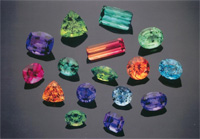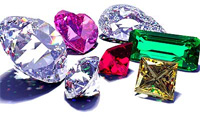Rate Chart & Tips
Only Trade Association of Pioneer Jewellers of Delhi & NCR Recognised by Ministry of Commerce - Govt. of India.
Tips for Buying
It's reasonable to expect lasting value and enjoyment when you purchase colored gemstone jewellery. Learning a few things about gemstone quality and value will help you make sure you get what you want – and deserve.
You can start by trusting your instincts. Sensory appeal is always paramount. So, if a particular gemstone or jewellery design "speaks" to you, by all means listen!
You can also use what you know about the 4Cs. The familiar diamond value factors of colour, cut, clarity, and carat weight apply to colored gems as well. However, each gem variety is judged by its own potential: no one expects an aquamarine to have the same colour as a sapphire or an emerald to be as flawless as an aquamarine. But there are a few general rules you can use to judge gemstone quality.
- The 4Cs
It’s reasonable to expect lasting value and enjoyment when you purchase gemstone jewellery. Learning a few things about gemstone quality and value will help you make sure you get what you want – and deserve.
You can start by trusting your instincts. Sensory appeal is always paramount. So, if a particular gemstone or jewellery design "speaks" to you, by all means listen!
You can also use what you know about the 4Cs. The familiar diamond value factors of colour, cut, clarity, and carat weight apply to colored gemstones as well. However, each gemstone variety is judged by its own potential: no one expects an aquamarine to have the same colour as a sapphire or an emerald to be as flawless as an aquamarine. But there are a few general rules you can use to judge gemstone quality.
- Colour
Some gemstones come in a multitude of colours, while others have more restricted palettes. Experts analyze all these chromatic options in terms of three essential components: hue, tone, and saturation. Hue is the basic colour sensation – blue, red, green, and so forth, plus blends like purplish red and violet-blue. Tone is a colour’s lightness or darkness, and saturation is its visual intensity.
Colours of pure hue, medium tone, and high saturation are generally most valuable, but different kinds of gems have differing potentials in this regard. For example, sapphire and tanzanite can reach a deeper blue than aquamarine, topaz, or zircon. Colour ranges can overlap to some extent, so different gemstones may have the same colour. Each is valued according to its own unique possibilities, however. Thus, the particular tint that's considered "best" for one gemstone might be "medium" for another.
In buying decisions you need to be aware of colour ranges and objective value assessments, but it’s best to rely on your eyes and heart. Pure or mixed, light or dark, vivid or muted – whichever colour holds the most appeal for you is the one to choose.
- Cut
Choices in cut are almost as varied as for colour – and they're every bit as intriguing. Transparent colored gemstones are most often faceted like diamonds, in dozens of geometric shapes and styles. The ancient domed form known as the cabochon is traditional for gemstones like jade, opal and turquoise. It helps to bring out the special optical effects seen in star gems and cat's-eyes, too. Today many kinds of gemstones are fashioned into carvings. These range from classic cameos and natural motifs to designs that push the edge of abstract expression.
Whatever the technique may be, cut is chiefly responsible for revealing a gemstone's beauty. Its contribution to appeal and value arises from the cutter's artistic creativity, technical skill and patient labour.
To judge the quality of cut, examine the gemstone as you hold it at arm's length and rock it gently back and forth. The overall form ought to be pleasing and dynamically balanced. Colour and light should dance throughout a faceted gemstone, with no washed out "window" in the centre or dead spots around the edges. When you look close-up, details like facet shape need to be precise, with polished surfaces appearing smooth and bright.
- Clarity
Most kinds of colored gemstones may have internal characteristics – or inclusions – that it's possible to see without magnification. Many of these are simply by-products of the natural processes that create gemstones within the Earth. Among the most common are tiny mineral crystals that became caught up in larger gemstone crystals as they grew. As long as such inclusions aren't prominent, they don't diminish a colored gemstone's beauty or desirability, and have little effect on its value.
Among the most common are tiny mineral crystals that became caught up in larger gemstone crystals as they grew. As long as such inclusions aren't prominent, they don't diminish a colored gemstone's beauty or desirability, and have little effect on its value.
There are some exceptions to this rule, however. You can expect a few gemstones to be "eye clean," with only microscopic clarity features. This list includes aquamarine, citrine, tanzanite, and topaz. On the other hand, inclusions in emerald and red tourmaline may be fairly obvious, but won't have a major impact unless they're also unsightly.
It's important to recognize that inclusions have a positive side, too. They can prove that the gemstones in which they occur are natural – not synthetic or imitation. Scientists study inclusions to learn the secrets of how gemstones form, and when viewed under a microscope, some are strikingly beautiful in their own right.
- Carat Weight
Like diamonds, most colored gemstones are weighed and priced by the carat. (One carat equals 1/5 gram.) As with colour, however, different kinds of gemstones have differing weight potentials. A few rarely exceed 5 carats in high quality. Many are readily available up to 15 or 20 carats and some can be even larger.
For gemstones with limited weight ranges, per-carat prices usually climb steeply as the carat weight goes up. For those with wider ranges, any increases tend to be more gradual. A 3-carat ruby might have a per-carat price that's three times higher than a 1-carat ruby of the same quality. As a result, the larger gemstone would cost nine times more than the smaller one. In contrast, a 5-carat amethyst is likely to have about the same per-carat price as a 1-carat amethyst, so it will cost only five times as much.
Besides reflecting the natural rarity of larger gemstones, per-carat price can serve as an indication of other value factors. If two gemstones of the same kind and weight have significantly different per-carat prices, there will be differences in colour, cut, or clarity, which you need to consider in a purchase decision.
- The Men's Manual to Buying Colour
- It's that special occasion for someone who's special, and you're not sure what the perfect gift should be. But you are sure you need something fast. Flowers are wonderful, but will fade in time, and you want this relationship to last a lifetime.
What about selecting a gift any woman would love to receive, one that will give her years of enjoyment - a gift of colored gemstone jewellery. Not sure where to start? Relax, it's easier than you think.
Just follow these four easy steps: - The first one is simple. What are her colour preferences?
What colours does she wear most often? Sometimes it is easier just to ask--what is her favourite colour? Whatever her colour preference, your jeweller is sure to have a gemstone he can recommend. - Find out what is available.
This web section is designed to show you all about the wonderful gemstone possibilities, most of which will bring a smile to that someone special. Once you have found something you like, your jeweller should be able to answer your questions about price and availability. - Don't think the "4Cs - cut, carat, clarity and colour - are just for Diamonds."
- Make sure you buy quality.
Remember the bitterness of poor quality lingers long after the sweetness of low price. Colour and rarity establish quality in a gemstone. Quality determines price. Refer to our section on Frequently Asked Questions to learn more about quality and price. If you have a choice between a small gemstone of better quality or a larger one of lower quality, you may want to go for the smaller one...an investment that will pay off in the long run.
- It's that special occasion for someone who's special, and you're not sure what the perfect gift should be. But you are sure you need something fast. Flowers are wonderful, but will fade in time, and you want this relationship to last a lifetime.
If, however, you are looking to make a statement that is big and bold, most gemstones come in a large range of qualities and sizes that allow you to match your mood with your budget.
![[Most Recent Quotes from www.kitco.com]](http://www.kitconet.com/charts/metals/platinum/t24_pt_en_ingr_2.gif)
![[Most Recent Quotes from www.kitco.com]](http://www.kitconet.com/charts/metals/gold/t24_au_en_ingr_2.gif)
![[Most Recent Quotes from www.kitco.com]](http://www.kitconet.com/charts/metals/silver/t24_ag_en_ingr_2.gif)
 Unless you have chosen a gemstone with a very unusual cut or one that is set in a custom made ring, there is no reason you can't have the gemstone you desire in a setting you prefer. An experienced jeweller can offer you a variety of designs or custom settings that can accommodate the gemstone you have selected. Also, many gemstones are cut to consistent dimensions, known as "calibrated" sizes. These gemstones fit into a variety of different settings. Ask your jeweller to help you select the perfect combination for you.
Unless you have chosen a gemstone with a very unusual cut or one that is set in a custom made ring, there is no reason you can't have the gemstone you desire in a setting you prefer. An experienced jeweller can offer you a variety of designs or custom settings that can accommodate the gemstone you have selected. Also, many gemstones are cut to consistent dimensions, known as "calibrated" sizes. These gemstones fit into a variety of different settings. Ask your jeweller to help you select the perfect combination for you.














